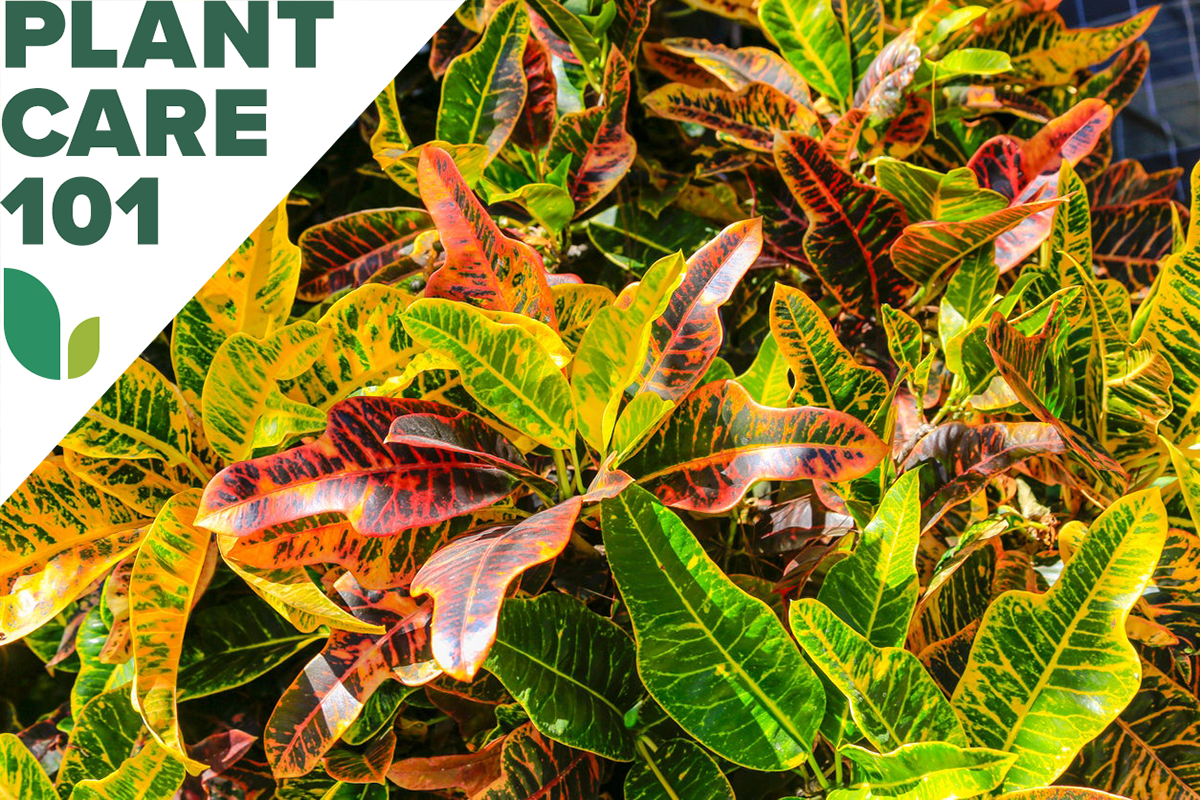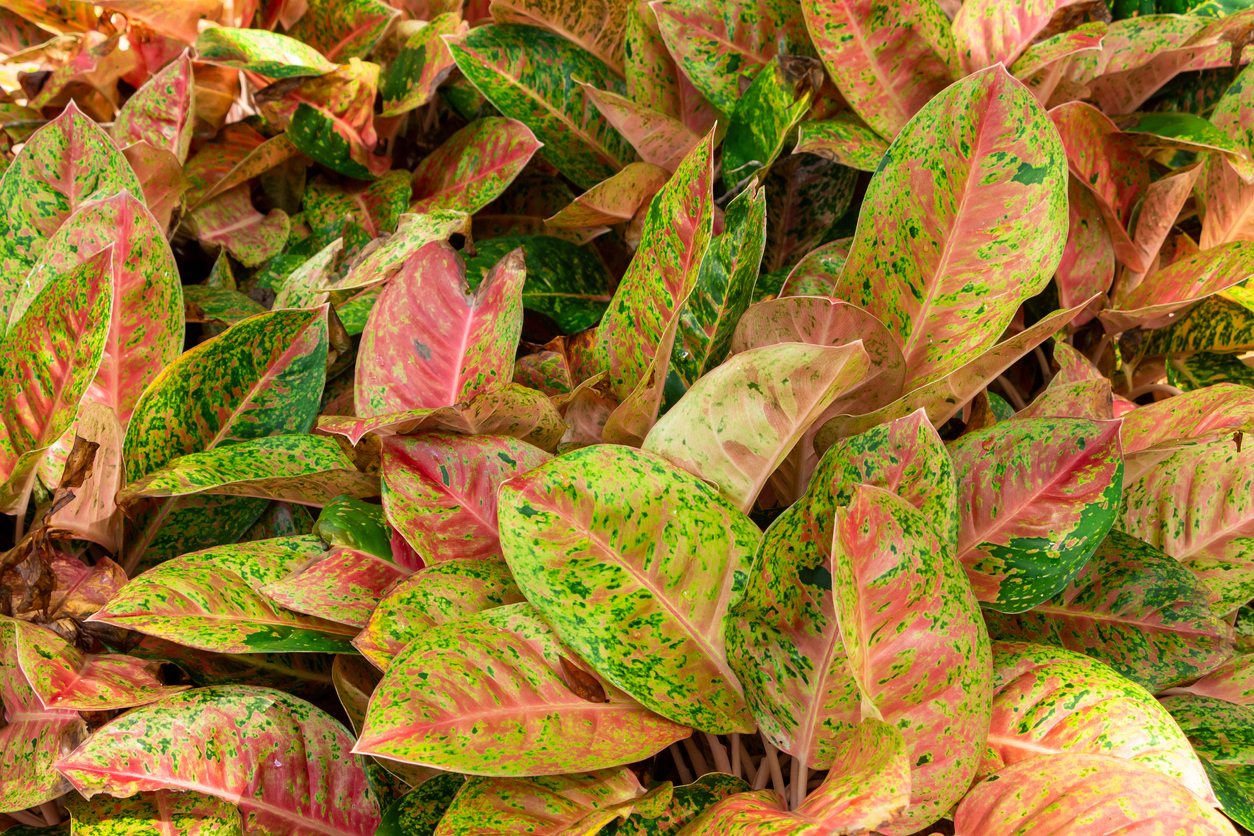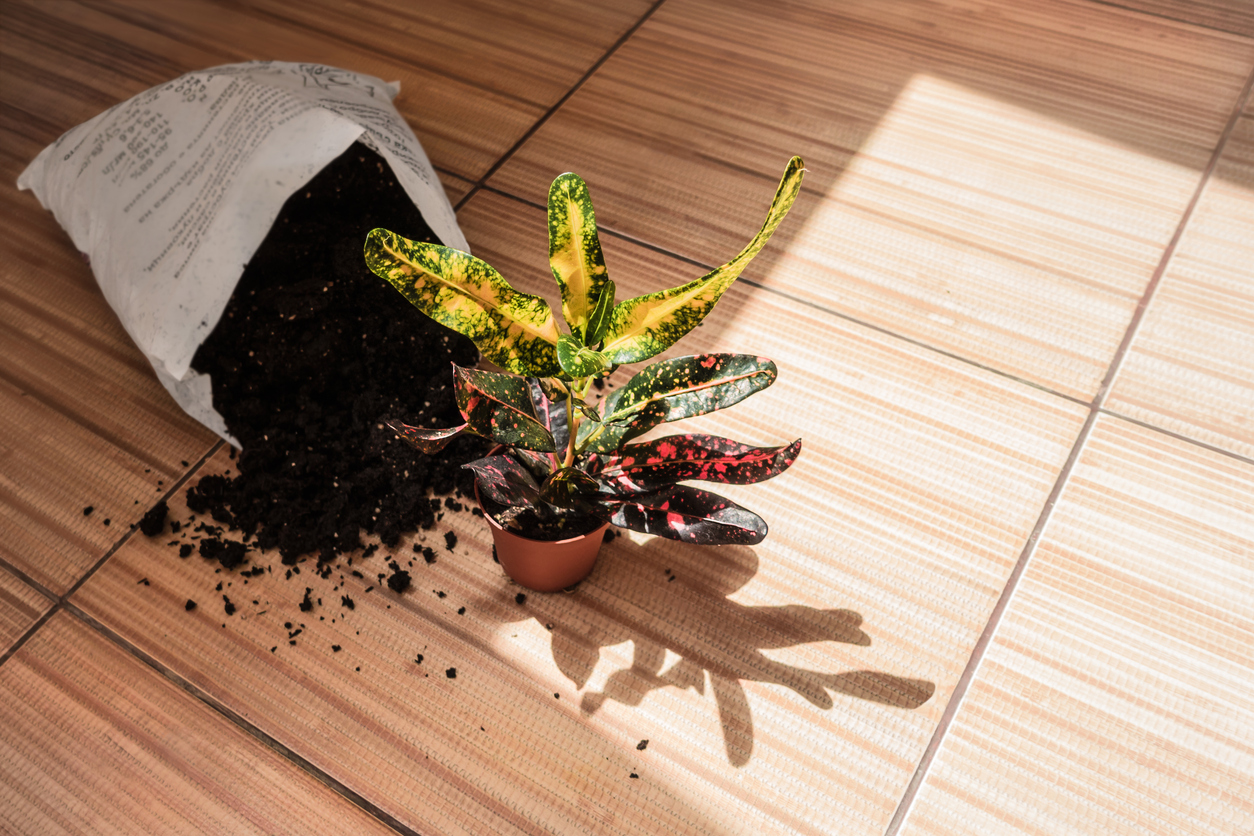

We may earn revenue from the products available on this page and participate in affiliate programs. Learn More ›
The croton also is called Joseph’s coat, and few other foliage houseplants can match the paintbox variety of bright hues with which the croton is daubed and dappled. However, like the original Joseph’s coat featured in the biblical tale, the houseplant version can cause problems.
There might be a reason why croton and crotchety begin with the same letter! Although easy to grow outdoors in tropical climates, this plant can be a diva indoors. So, croton plant care may prove demanding for beginners, but more experienced gardeners should enjoy the challenge.
Croton Plant Care at a Glance
Common Name: Croton, Joseph’s coat
Scientific Name: Codiaeum variegatum var. pictum
Soil: Standard potting soil
Light: Partial sun
Water: Medium
Food: Balanced houseplant fertilizer
Temperature and Humidity: 60 to 85 degrees Fahrenheit, humid
Propagation: Cuttings or air layering
Safety: Possible mouth and skin irritant
Croton Plant Characteristics
Croton is more officially known as Codiaeum variegatum var. Pictum. Pictum means “painted.” And the plant’s leathery leaves indeed look like they’ve been painted in a variety of colors with red, orange, and yellow being the predominant ones—often drawn in as brighter veins against a background of dark green or purplish-black. The leaves range from 2 to 12 inches long and vary from typical oblong ones to lobed, strappy, or even twisted types.
Native to tropical forests of southeast Asia and the Pacific Islands, and sometimes grown outdoors in USDA zones 11 or 12, garden croton varieties can reach 10 feet under those conditions. They also may produce racemes of nondescript white male flowers and yellowish female ones in spring. But the potted indoor plants seldom bloom and probably won’t surpass 4 feet.
Related: 20 Huge Houseplants That Make a Statement
Types of Croton Plants
- ‘Petra:’ One of the types most commonly recommended for lower light indoor conditions, this cultivar has oval leaves marked with red, orange, and yellow.
- ‘Red Iceton:’ Those who prefer pastel colors to croton’s frequently neon ones can opt for this chartreuse, cream and yellow variety, tinted with a “red” that often appears pink.
- ‘Revolutions:’ Considered one of the easiest crotons to grow indoors by houseplant maven Tovah Martin, this dwarf cultivar is all green but with unusual curly leaves.

Selecting Soil for Croton Plants
Your croton plant should thrive in a standard potting soil with a pH between 4.5 and 6.5. Alternatively, you can grow it in a mix composed of six parts peat moss, three parts ground pine bark, and one part coarse builder’s sand. Lacking the pine bark, you can make that three parts peat moss to one part sand.
If you need to repot your plant, do so in spring and move it into a pot only one size larger (no more than 1 to 2 inches bigger) than the previous one. Keep in mind that the croton does not like change, so you probably should return it to the same position it occupied previously if the plant was thriving there.
The Right Light
Part of the problem with growing this plant is that even experts disagree on croton light requirements, with some sources recommending as much sun as possible and others advocating hardly any at all. That probably can be attributed to certain cultivars preferring more rays than others.
Under those circumstances, follow the directions given for your cultivar. If you lack such instructions, opt for a middle course and try giving the plant about four hours of sun per day in an east- or west-facing window.
Should its leaves begin to revert to all green with the lowest ones dropping, they aren’t receiving enough light, and you might want to move the plant to a south-facing window instead. If the foliage takes on a grayish bleached look or its yellow sections turn black, the plant is receiving too much sun and should have a sheer curtain placed between it and the glass.
Related: The One Rule of (Green) Thumb When Decorating With Houseplants
Watering Croton Plants
Keep your croton houseplant’s soil lightly moist at all times during the spring and summer months when the days are long and bright, since the plant reportedly transpires—“sweats” water off as vapor—a lot. As the days begin to shorten again in autumn, reduce the amount of moisture you give your croton, watering it only when its soil is dry 1 to 2 inches down. That helps protect it against the root rot that can become a problem with over-irrigated houseplants during winter.
If possible, use room temperature rainwater or bottled spring water rather than hard tap water. And keep in mind that if the most tender new foliage—that at the tip of the plant—wilts, it probably means your plant is too dry. Don’t let such desiccation happen too often, or your croton might begin shedding all of its leaves in protest.

Fertilizing Croton Plants
Fertilize your croton once every two weeks during spring and summer with a balanced plant food such as 20-20-20 at half strength, or once per month at full strength. Stop feeding it during fall and winter unless it receives enough light to continue growing during those seasons.
Oddly shaped foliage is an intended feature for some croton cultivars and not always something you need to worry about. However, curled leaves on a type that is not supposed to have them and/or brown leaf tips could indicate that you have been feeding your plant too much and should put it on a “water-only” diet instead.
Setting the Temperature and Humidity
As with most tropical beauties, the croton likes to stay warm at temperatures between 60 and 85 degrees Fahrenheit. If you take your houseplant outdoors over the summer months, remember to bring it back in before temperatures drop below 50. And keep it away from exterior doors and ill-fitting windows during winter to prevent cold drafts from affecting the plant.
Also, when the air indoors turns dry due to heating or air conditioning, do what you can to raise humidity levels around the plant. In addition to use of a misting bottle and/or humidity tray, that can include placing the croton in a brightly lit bathroom, near a sink, or in a crowd of other houseplants.
Related: The 26 Best Plants for Bathroom Decor
Propagating Croton Plants
If your croton houseplant has become spindly or if you simply want to make more of it, take a few 4- to 6-inch cuttings. After removing any lower leaves on them and keeping at least three leaves each at the tips, place them in a glass containing a couple inches or so of water.
Place the cuttings in a warm location where they receive bright, indirect light and add more water as necessary to keep them from drying out. Once the cuttings have roots 2 inches long, they can be potted up. Leggy crotons also can be propagated via air layering.
Safety Considerations
Even though this often green and yellow leaf plant isn’t included on the ASPCA’s list of those poisonous to pets, the mature leaves reportedly can cause a burning sensation in the mouth of humans when consumed, so they might do the same in animals. The croton’s white sap also can irritate the skin of sensitive individuals, though not everyone is affected by it.
Even if it doesn’t redden your epidermis, that “latex” could stain any material onto which it drips, so it’s a good idea to wear plastic gloves when pruning croton and to place the plant atop an easily cleanable surface while doing so.

Potential Pests and Diseases
Falling leaves, a common characteristic of this plant when it is miffed, can indicate any one or more of a variety of issues, including that it is too cold, too dark, too dry, or too stressed out from a recent move. Brown-tipped leaves often hint at low humidity or overfeeding.
Though not frequently bothered by insects—perhaps due to its stiff and not very palatable foliage—croton can still harbor a few from time to time. To help prevent aphids, mealybugs, and spider mites from taking up residence in the first place, clean your croton’s leaves and stems on all sides frequently with a lint-free cloth dampened with lukewarm water. In the process, you can scrub off any bugs that appear as well.
FAQs About Croton Plant Care
Although answers about croton seldom are simple, you can find a few quick ones below. (Keep in mind, though, that croton care often can vary depending on the cultivar involved.) If these don’t answer your question, you may want to consult the more extensive information above in your quest to get your Joseph’s coat to show its true colors!
That depends on the cultivar. Some prefer full sun, some partial sun, and some bright, indirect light. Try partial sun first and see how your plant reacts.
Not necessarily. Some crotons can thrive in bright, indirect light, while others may lose their bright colors and revert to more green due to the lower illumination.
They can be diva-ish and sulk if their preferred conditions aren’t met, but many plant lovers get the hang of croton care with a little knowledge and time.
Water your croton enough to keep its soil lightly moist during spring and summer, but allow it to dry out an inch or two down during winter.
Prune it back in spring to force it to branch out more, cutting about 1 foot above where you want it to sprout new growth.
Crotons drop their leaves for a variety of reasons, including as a reaction to a recent move or because they are being kept too dark, too dry, or too cold.
